
| Going Bigger |
| FCC Approving Larger, Higher Antennas for More Signal Coverage |
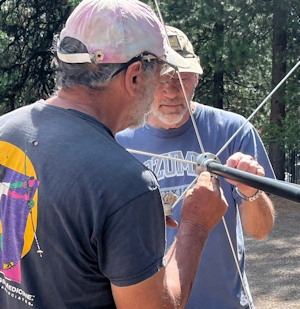 |
| Left to Right: Volunteer Randy Damsen (NB6X) and Peninsula Fire Protection District’s Board Member Mark Burham (K6FEJ) assemble the RadioSAFE (HPR.0990) Antenna near Lake Almanor. |
| Photo Courtesy of Peninsular Fire Protection District |
| LAKE ALMANOR CA: A new, expanded-coverage RadioSAFE system at Lake Almanor, California, will provide a signal intended to envelop the region in northern California with information that could be critical in the next emergency. In May an earthquake near the Lake rattled plenty of nerves. In recent years wildfires have approached the area and just missed, sparking the need for the service. Cellular coverage in the area is spotty; and if power is severed or turned off, residents may suddenly find themselves in an information desert. |
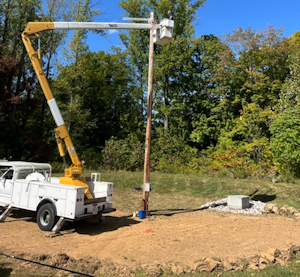 |
| Tuning Morgan County's RadioSAFE Antenna |
| Photo Courtesy of Electronic Communication Systems |
| Martinsville, IN: Morgan County, Indiana, is one of many communities seeking to cover the most real estate possible by requesting that FCC approve signal coverage and antenna height waivers for their RadioSAFE service. Previously the County operated a portable radio system that provided conventional coverage. Now, County safety officials are watching the April date rapidly approach when they expect throngs of eclipse tourists to descend on Southern Indiana to see the moon’s shadow go by. Radio will be an efficient way to reach out with safety information during the event. |
| ORANGEBURG COUNTY, SC: Orangeburg County in South
Carolina has announced it will be installing 12
RadioSAFE systems intended to blanket the region, which is
prone to flooding. The recent passing of Hurricane
Idalia in August pointed to the need for an emergency
information system resilient enough to provide updates
when grid power and conventional communications are
lost. FCC allows safety agencies to seek waivers of antenna height, signal coverage and other parameters for both new and existing Information Radio Stations. At present, more than two dozen such waivers have been granted, permitting licensees to cover more ground cost effectively. |
| * * * |
| Low Power FM Window to Open ̶ Again |
| WASHINGTON, DC: FCC has just announced that the application window for Low Power FM (LPFM) stations is being moved to December 6-13, 2023. The Source is just letting you know in case you are asked to explain why your agency isn’t applying for one. The LPFM service is not considered a good fit for most public safety agencies due to 1) limited frequencies available in populated areas, 2) requirements for new live programming daily, 3) the strict limitations on licensing and renewability and 4) the secondary status making them vulnerable to being sidelined by new FM broadcast stations and translators. Here are even more reasons why public safety agencies do not embrace LPFM. For more information on the service, see also the FCC’s LPFM webpage. |
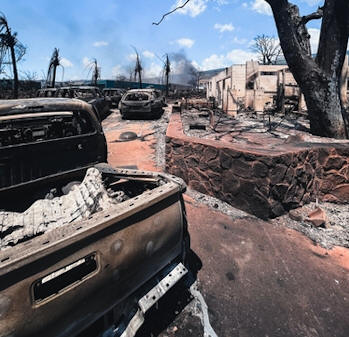 |
| The Aftermath at Lahaina |
| Shutterstock Photo |
| Radio Aids Maui Recovery |
| Hawaii’s Emergency Management Agency Deploys Temporary Radio Stations to Advise Returning Residents |
| LAHAINA, HI: What took an instant to incinerate will require lifetimes to rebuild. As Maui residents return to reclaim what remains, their Emergency Management Agency is keeping them updated by radio. Not surprisingly, their first radio antenna location is in the Town of Lahaina on the high school gym, which thankfully was spared. Broadcasts may include a wide array of details critical for re-entering residents: locating shelter and food assistance, air quality updates and the status of service restorations such as water and electricity. |
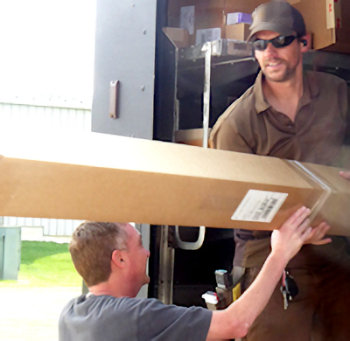 |
| Radio Shipments Headed for Maui |
| Then there are the residents of communities such as Lahaina and Kula who can no longer gain access to their homes. “Displaced people have moved out to areas like Kihei and Kahului and are living with relatives, or some are in hotels,” Walt Pacheco, Communications Coordinator with the Maui Police Department, told The Source. The second radio station is being set up now in the island’s major city, Kahului – one of four RadioSTAT systems currently at the Agency’s disposal. |
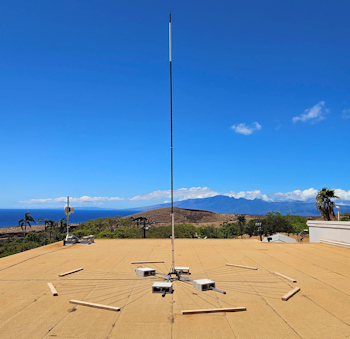 |
| RadioSTAT Antenna in Evidence atop the Lahainaluna High School Gym |
| Photo Courtesy of Harmer Communications |
| See RadioWorld's story "Hawaii Puts AM Radio to Work on Maui -- The state has acquired four portable emergency advisory radio systems." Aug 22, 2023. |
| Everything in Modulation | |||
| Information Station Specialists Turns 40 | |||
| ZEELAND, MI: Information Station Specialists began in 1983 as a one-man service provider for the newly-minted Travelers Information Station (TIS) industry – filing licenses, voicing audio and performing installations. Today, the niche company continues to do all of that along with manufacturing transmitters, antennas and a spectrum of custom products that deliver information to the public. Added along the way: portable signage, internet streaming services and now solutions for broadcast stations and the HAM Radio market. | |||
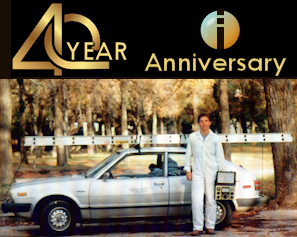 |
|||
|
Information Station Specialists Technician on an
Early Installation at San Antonio International Airport |
|||
| Shutterstock Graphic | |||
| Comments founder
Bill Baker, “We’ve tried to treat our customers right,
and in return, they’ve more than treated us right, year
after year.” In a marketplace hungry for
consistency, Information Station Specialists has been a
bright exception – maintaining the same phone number and
mailing address for 37 years. The majority of
company employees have been with the firm for more than
two decades. “We’ve survived two recessions, the pandemic, the internet, bird-flu, smartphones and even Y2K,” comments Baker. “Whatever comes next, we can probably help you tell the public about it.” |
|||
 |
|||
 |
|||
 |
|||
 |
|||
| Information Station Specialists is credited with introducing key technologies into the Information Radio Station industry over its 40 years, including: | |||
|
|||
| See theRADIOsource.com for more. |
PO Box 51, Zeeland, Michigan, USA, 49464-0051, Phone 616.772.2300, Email
• • •